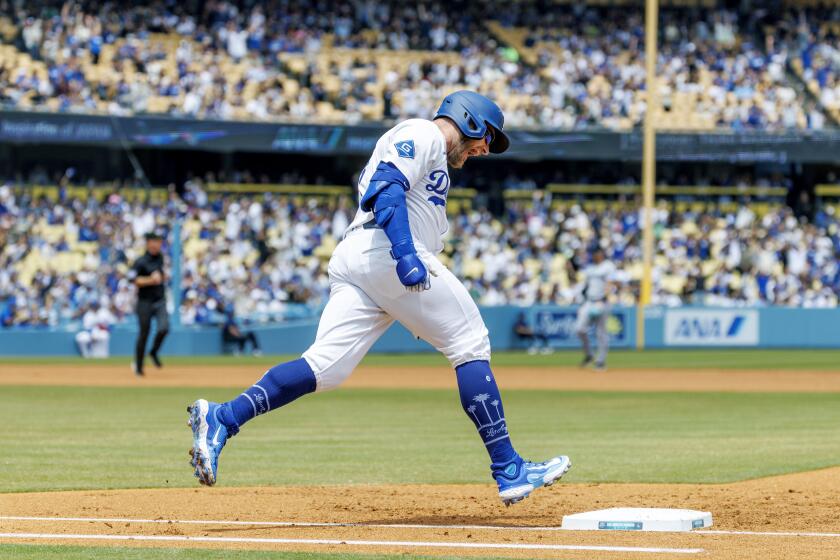USADA report details case against Lance Armstrong
- Share via
Casting new shadows over one of sport’s most iconic figures, anti-doping investigators Wednesday presented a battery of highly detailed allegations against Lance Armstrong, accusing the famed cyclist of running the most sophisticated doping scheme in sports history.
The U.S. Anti-Doping Agency report is the most comprehensive look at Armstrong’s alleged doping. It offers more than 200 pages of lab results, testimony from 11 former teammates and financial records showing $1 million in payments to a company controlled by an Italian doctor connected to performance-enhancing drugs.
The result is a portrayal of Armstrong as a world-class athlete who began using EPO and other banned substances as early as 1998, orchestrating clandestine deliveries along mountain roads and holding secret meetings in which he pressured fellow cyclists to join him in cheating for the betterment of the team.
Dogged by suspicions of doping for years, the seven-time Tour de France winner has consistently denied any wrongdoing, asserting that he has never failed a drug test. Now he faces a raft of more damning and specific allegations.
On Wednesday, his lawyer characterized the USADA report as nothing more than testimony from “ax-grinders” and “serial perjurers.”
“Ignoring the 500-600 tests Lance Armstrong passed, ignoring all exculpatory evidence, and trying to justify the millions of dollars USADA has spent pursuing one, single athlete for years, USADA has continued its government-funded witch hunt,” attorney Tim Herman said in a statement.
USADA first launched proceedings against Armstrong last summer. After failing to block the investigation in court, he announced that he was tired of fighting and chose not to contest the allegations in a scheduled USADA hearing.
The agency subsequently stripped him of his titles and banned him from competition for life. On Wednesday, officials released the evidence they had planned to present at the hearing, saying they wanted to be open about the reasons for the ban.
The allegations refer to Armstrong’s years with the U.S. Postal Service and Discovery Channel cycling teams. Whereas past claims originated with controversial riders such as Floyd Landis, this report included testimony from teammates such as close friend George Hincapie.
In discussing his earliest alleged doping, witnesses said that an individual known only as “Motoman” often delivered drugs to the team along mountain rides.
In another instance, Betsy Andreu, the wife of an Armstrong teammate, said Armstrong accepted a brown paper bag and commented to her, “Liquid gold.”
Witnesses said Dr. Michele Ferrari orchestrated the doping schedules for the USPS and Discovery Channel teams from 1999 through 2005.
USADA investigators claim that accounting records for Ferrari’s company in Switzerland show a history of large payments from Armstrong, totaling $475,000 in 2003 alone.
“Lance Armstrong surrounded himself with drug runners and doping doctors so that he could achieve his goal of winning the Tour de France year after year,” the report stated.
Christian Vande Velde, a USPS team member, told investigators that during a 2002 meeting, Armstrong and Ferrari pressured him to step up his use of performance-enhancing drugs.
“Lance called the shots on the team,” he said. “What Lance said, went.”
After an Italian court convicted Ferrari of sporting fraud in 2004 for advising cyclists on the use of Andriol and EPO, Armstrong publicly vowed to cut all ties to the doctor.
But teammate Tom Danielson told USADA that he and Armstrong continued to work with Ferrari in the months before Armstrong won another Tour de France.
According to the report, records show that Armstrong subsequently wired $100,000 to Ferrari’s company.
The report also pointed out some statements Armstrong has made in court as false, and also scolded him for intimidation of witnesses, including a text message he reportedly sent to Levi Leipheimer’s wife after Leipheimer testified to a Los Angeles County grand jury and the former teammates ended sitting next to each other at a dinner: “Run, don’t walk.”
As word of the report spread in recent days, there was speculation that at least some of the evidence would come from the recent U.S. attorney’s investigation.
Federal prosecutors called numerous witnesses before a grand jury but ultimately chose not to pursue charges.
None of that testimony found its way into the USADA report. Still, the array of teammates who spoke to USADA investigators — in some cases despite their close relationships with Armstrong — was surprising.
“It is extremely difficult today to acknowledge that during a part of my career I used banned substances,” Hincapie said in a statement Wednesday.
“I would have been much more comfortable talking only about myself, but understood that I was obligated to tell the truth about everything I knew,” he continued. “So that is what I did.”
In addition to testimony and financial records, USADA cited tests of Armstrong’s blood samples from the late 2000s that its specialist claimed were “consistent with blood doping.”
At least one crisis expert with experience in the world of sports said that Armstrong, diagnosed with testicular cancer in 1996, has earned a lot of good will for the work his Livestrong foundation has done with cancer survivors.
Jason Maloni of LEVICK, a Washington-based company, also noted USADA’s lack of concrete test results, finding some wiggle room for Armstrong.
“It’s still a he-said/she-said,” Maloni said. “It still leaves room for a lot of doubt.”
USADA officials saw things differently, stating in their document: “This [report] includes a summary of the overwhelming evidence that demonstrates that Mr. Armstrong doped throughout the majority of his professional cycling career.”
More to Read
Go beyond the scoreboard
Get the latest on L.A.'s teams in the daily Sports Report newsletter.
You may occasionally receive promotional content from the Los Angeles Times.












